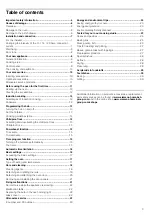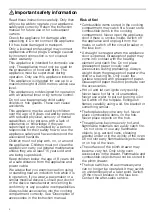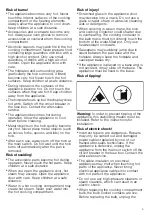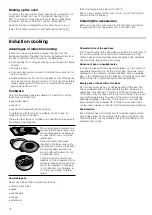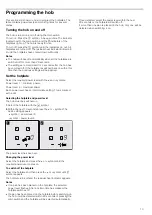
6
appliance from the mains or switch off the
circuit breaker in the fuse box.
Risk of electric shock!
■
A defective appliance may cause electric
shock. Never switch on a defective
appliance. Unplug the appliance from the
mains or switch off the circuit breaker in
the fuse box. Contact the after-sales
service.
Risk of electric shock!
■
Cracks or fractures in the glass ceramic
may cause electric shocks. Switch off the
circuit breaker in the fuse box. Contact the
after-sales service.
Causes of damage
Hob
Caution!
■
Rough pan bases may scratch the hob.
■
Avoid leaving empty pots and pans on the hotplate. Doing so
may cause damage.
■
Do not place hot pans on the control panel, the indicator
area, or the hob frame. Doing so may cause damage.
■
Hard or pointed objects dropped on the hob may damage it.
■
Aluminium foil and plastic containers will melt if placed on the
hotplate while it is hot. The use of laminated sheeting is not
recommended on the hob.
Overview
The following table provides an overview of the most frequent
kinds of damage:
Damage to the oven
Caution!
■
Accessories, foil, greaseproof paper or ovenware on the
cooking compartment floor: do not place accessories on the
cooking compartment floor. Do not cover the cooking
compartment floor with any sort of foil or greaseproof paper.
Do not place ovenware on the cooking compartment floor if a
temperature of over 50 ºC has been set. This will cause heat
to accumulate. The baking and roasting times will no longer
be correct and the enamel will be damaged.
■
Water in a hot cooking compartment: do not pour water into
the cooking compartment when it is hot. This will cause
steam. The temperature change can cause damage to the
enamel.
■
Moist food: do not store moist food in the cooking
compartment when it is closed for prolonged periods This will
damage the enamel.
■
Fruit juice: when baking particularly juicy fruit pies, do not
pack the baking tray too generously. Fruit juice dripping from
the baking tray leaves stains that cannot be removed. If
possible, use the deeper universal pan.
■
Cooling with the appliance door open: only allow the cooking
compartment to cool when it is closed. Even if the appliance
door is only open a little, front panels of adjacent units could
be damaged over time.
■
Very dirty door seal: If the door seal is very dirty, the
appliance door will no longer close properly when the
appliance is in use. The fronts of adjacent units could be
damaged.Always keep the door seal clean.
■
Appliance door as a seat, shelf or worktop: Do not sit on the
appliance door, or place or hang anything on it. Do not place
any cookware or accessories on the appliance door.
■
Inserting accessories: depending on the appliance model,
accessories can scratch the door panel when closing the
appliance door. Always insert the accessories into the
cooking compartment as far as they will go.
■
Carrying the appliance: do not carry or hold the appliance by
the door handle. The door handle cannot support the weight
of the appliance and could break.
Damage to the plinth drawer
Caution!
Do not place hot objects in the plinth drawer. It could be
damaged.
Damage
Cause
Action
Stains
Food spills
Remove spills immediately with a glass scraper.
Unsuitable cleaning agents
Only use cleaning agents which are suitable for ceramic
Scratches
Salt, sugar and sand
Do not use the hob as a work surface or storage space.
Rough pot and pan bases scratch the
ceramic.
Check your cookware.
Discolouration
Unsuitable cleaning agents
Only use cleaning agents which are suitable for ceramic
Pan abrasion (e.g. aluminium)
Lift the pots and pans when moving them.
Blisters
Sugar, food with a high sugar content Remove spills immediately with a glass scraper.



